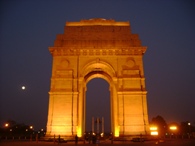 | « Back to article | Print this article |
 Only the cars shine in Delhi's gloomy weather, says Subir Roy.
Only the cars shine in Delhi's gloomy weather, says Subir Roy.
The wife and I can never agree on when to visit Delhi. She wants to avoid winter as she dreads the fog and the driving hazards that it creates. I love the cold and the fog which sweeps the landscape with a gentle brush, taking away the rough edges and imbuing the ordinary with a fairytale look.
But appointments and meetings don't know the fog or the cold and so there we were, thanking our stars that we were spared the unending wait at Bangalore airport, which passengers had suffered the previous day because of the chaos at Delhi airport, thanks to the failure of the new and costly instrument landing system.
The cold and the grey were very much there to greet us, plus there was the lightest of drizzle which was gone almost before it came. A good omen, I thought. Maybe, the cold, clear sunny spell - the best part of winter - that the city had just had would come back.
But over the next few days things got worse and you couldn't blame it entirely on the weather. Dust and north India go hand in hand but development can make things much worse.
Digging and construction, on and off the road, in a rush to get things spic and span before the Commonwealth games, cast a pall of dust over every conceivable surface. The concrete of the new construction, flyovers finished and unfinished, enhanced the greyness of the dust.
To all this the gray light of the overcast sky, through which the sun only occasionally peered, added its bit. My friend who worked out of his second floor barsati office suddenly interrupted our late afternoon conversation to say excitedly, the sun is out, let's go sit on the terrace.
The sun was indeed out, but it looked more like a pale declining late evening moon which had lost its earlier full moon vigour. Then after briefly marking its presence it was gone, like a sarkari karamchari who turns up only to sign the attendance register and is not seen thereafter.
As the sun disappeared and the clammy cold almost got to the bones, we hastily went indoors. The brightness of the strip lighting could not take away the gloom outside and within us.
In this greyness, the only bright objects were the cars. The wife and I both observed that Delhi seemed to have acquired even more cars than before. And these armies of cars alternately sped and crawled along arterial roads that undulated over flyovers, having virtually done away with traffic lights.
Delhi has, in recent years, travelled so much closer to a signal-free nirvana. The only problem was that we occasionally lost the turn we were looking for as we should not have got on to a new flyover but gone around it.
Quite a few walkways and underpasses were there doing their bit to rejoin communities on either side of roads that were threatened with permanent division. But how many of them can you build.
A new autonomy, that of endless good wide roads carrying an infinite number of cars, had redefined the city which was seeking to rebuild its life, just as the lower reaches of rivers in Assam and Bengal (west and east) change course without notice, sweeping away villages and the life around them, forcing humanity to rebuild lives along the new alignment.
The ascendancy of the car came home to roost when the Auto Expo opened. There were huge jams for around 5 km radius from Connaught Place as people came in cars to see the cars on display. I planned to visit my old office at ITO, but was warned that I should set aside a couple of hours simply to go and come back.
A friend bemoaned that it had taken him two hours to go from his office to Gurgaon where he had shifted more than a decade ago in a replay of the American suburban dream that had now gone sour.
Within the city and the new suburbs, the cars had one new destination. When I had a few minutes to kill before meeting a veteran journalist at Saket's Press Enclave, I suggested to the driver he take me to the nearby market for a cup of tea.
He suggested instead the mall and there were not one but two of them, where earlier I had known wide open spaces. At the mall, I was down by Rs 70 for a coffee when all I had wanted was a cup of tea for under Rs 5.
And in this brave new world at gatherings in the evenings people mentioned absurd values. A retired friend in one of the better known south Delhi colonies said he was providing for his pension, building a first floor which he would rent out for maybe a lakh a month. Before I could recover my breath, he told me that I had been a fool to have sold my Gurgaon house when I did. By now it would have gone up in value five times in six years.
The British created cities where malaria-infested swamps had been because commerce beckoned. Money and value propositions similarly dictate the unending growth of Delhi.
But the nineteenth century presidency towns created a better quality of life for those who could afford to flock to them. What is the quality of life in the unbearable dusty greyness of Delhi?